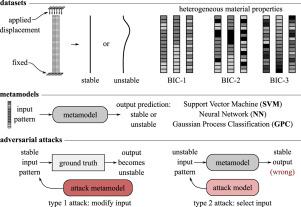Computer-Aided Design ( IF 3.0 ) Pub Date : 2020-10-15 , DOI: 10.1016/j.cad.2020.102948 Emma Lejeune

|
Many recent advances in machine learning have been motivated by classification problems. For example, classification methods are used to differentiate between “spam” and “non-spam” emails, identify hand written digits, and recognize the content of photos. For each application, a different model and model architecture will often perform best. Therefore, machine learning research has been enabled by readily available benchmark datasets. In particular, benchmark datasets have been used by researchers to demonstrate that novel methods can achieve high accuracy, and to demonstrate common vulnerabilities of classification methods to adversarial attacks. In the recent mechanics literature, there has been substantial interest in machine learning driven metamodels. Metamodels, or models of models, are appealing because once trained, they typically require orders of magnitude less compute time than full fidelity simulations. However, a better understanding of which machine learning methods and model architectures will perform best on mechanical data has been limited. Here we introduce an open source dataset “BIC” (Buckling Instability Classification) where a heterogeneous column is subject to a fixed level of applied displacement and is classified as either “Stable” or “Unstable.” In addition to introducing this benchmark dataset, we show baseline metamodel performance, and show two different types of adversarial attack. We anticipate that the open source BIC dataset will enable the future development of improved methods for classification problems in mechanics.
中文翻译:

几何稳定性分类:数据集,元模型和对抗性攻击
分类问题推动了机器学习的许多最新进展。例如,使用分类方法来区分“垃圾邮件”和“非垃圾邮件”,识别手写数字并识别照片的内容。对于每个应用程序,不同的模型和模型体系结构通常会表现最佳。因此,机器学习研究已经通过随时可用的基准数据集得以实现。尤其是,研究人员已使用基准数据集来证明新颖的方法可以实现较高的准确性,并证明了分类方法在对抗性攻击中的常见漏洞。在最近的力学文献中,人们对机器学习驱动的元模型产生了浓厚的兴趣。元模型或模型模型之所以吸引人,是因为一旦受过训练,与全保真度仿真相比,它们通常需要少几个数量级的计算时间。但是,对于哪种机器学习方法和模型体系结构将在机械数据上表现最佳的了解有限。在这里,我们介绍了一个开源数据集“ BIC”(屈曲不稳定性分类),其中异类列受到固定级别的施加位移并被分类为“稳定”或“不稳定”。除了介绍此基准数据集外,我们还展示了基准元模型的性能,并展示了两种不同类型的对抗性攻击。我们期望开源的BIC数据集将为将来的力学分类问题改进方法的开发提供支持。对哪种机器学习方法和模型体系结构将在机械数据上表现最佳的更好的理解已经受到限制。在这里,我们介绍了一个开源数据集“ BIC”(屈曲不稳定性分类),其中异类列受到固定级别的施加位移并被分类为“稳定”或“不稳定”。除了介绍此基准数据集外,我们还展示了基准元模型的性能,并展示了两种不同类型的对抗性攻击。我们期望开源的BIC数据集将为将来的力学分类问题改进方法的开发提供支持。更好地了解哪种机器学习方法和模型架构将在机械数据上表现最佳是有限的。在这里,我们介绍了一个开源数据集“ BIC”(屈曲不稳定性分类),其中异类列受到固定级别的施加位移并被分类为“稳定”或“不稳定”。除了介绍此基准数据集外,我们还展示了基准元模型的性能,并展示了两种不同类型的对抗性攻击。我们期望开源的BIC数据集将为将来的力学分类问题改进方法的开发提供支持。在这里,我们介绍了一个开源数据集“ BIC”(屈曲不稳定性分类),其中异类列受到固定级别的施加位移并被分类为“稳定”或“不稳定”。除了介绍此基准数据集外,我们还展示了基准元模型的性能,并展示了两种不同类型的对抗性攻击。我们期望开源的BIC数据集将为将来的力学分类问题改进方法的开发提供支持。在这里,我们介绍了一个开源数据集“ BIC”(屈曲不稳定性分类),其中异类列受到固定级别的施加位移并被分类为“稳定”或“不稳定”。除了介绍此基准数据集外,我们还展示了基准元模型的性能,并展示了两种不同类型的对抗性攻击。我们期望开源的BIC数据集将为将来的力学分类问题改进方法的开发提供支持。











































 京公网安备 11010802027423号
京公网安备 11010802027423号